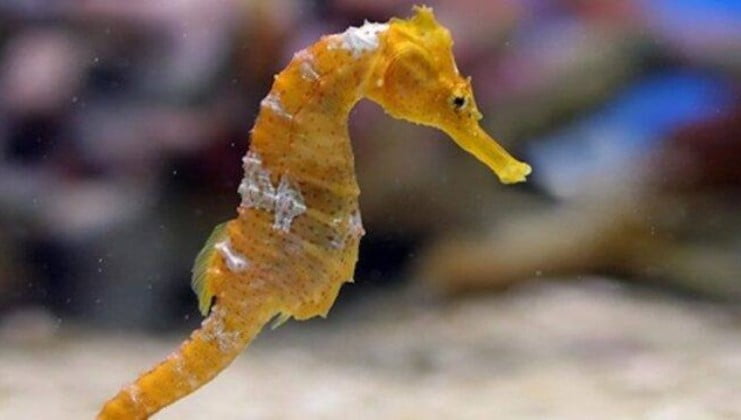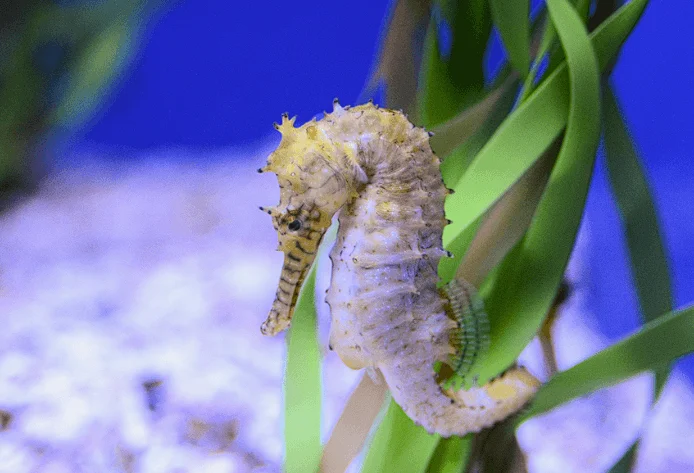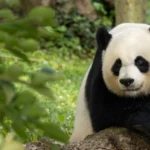Seahorses are unique and fascinating creatures that inhabit the world’s oceans. Their distinct appearance and behaviors captivate the imagination of people of all ages. These small, delicate creatures are known for their monogamous relationships, prehensile tails, and ability to move each eye independently. In this article, we will discuss some fun facts about seahorses that showcase their remarkable characteristics and highlight why they are such an intriguing species. From their big appetite to unique identifying markings, there is much to discover about these charming creatures.
Fun Facts About Seahorses

Image Source: Instagram @infotainmentbeats
The followings are some fun facts about seahorses:
- Seahorses belong to the family Syngnathidae, which includes pipefish and seadragons and are classified as fish due to their possession of gills, fins, and a swim bladder.
- The smallest seahorse species is the pygmy seahorse (Hippocampus bargibanti), which is only about 14 to 16 millimeters long.
- Male seahorses undergo pregnancy and carry the developing eggs. As the female deposits them into the male’s specialized pouch for fertilization and nurturing until birth.
- Seahorses are known for their monogamous behavior. Forming long-term pair bonds lasting for multiple breeding seasons and engaging in courtship rituals.
- Despite being poor swimmers, seahorses use their dorsal fins to propel themselves and often anchor themselves to structures to conserve energy.
- Seahorses lack stomachs but have big appetites, needing to consume large amounts of food, such as plankton, small fish, and crustaceans, by sucking them up through their long snouts.
- Seahorses can change color and blend in with their surroundings, utilizing camouflage for protection and hunting by mimicking their environment.
- There are more than 50 recognized species of seahorses, each displaying unique characteristics in terms of size, color, and patterns.
- Seahorses are found on every continent except Antarctica, inhabiting shallow coastal waters. And tropical regions across the Atlantic, Pacific, and Indian Oceans, as well as the Mediterranean Sea.
- Seahorses face threats such as habitat destruction, pollution, overfishing, and exploitation of traditional medicine, curiosities, and the aquarium trade.
- Conservation efforts are crucial to protect seahorse populations and their fragile ecosystems, including preserving seagrass beds and implementing sustainable fishing practices.
READ ALSO: Dolphins Interesting Facts | Incredible Feats Of Dolphin Acrobatics
Facts You Need To Know

Image Source: Instagram @seahorsesfacts
- Their horse-like appearance, including a horse-shaped head, long snout, and arched neck resembling a horse’s posture, earns seahorses their name “seahorses.”
- Despite their small size, seahorses have a large appetite and feed on tiny marine organisms like crustaceans and zooplankton, sucking them into their mouths with long snouts. They can consume up to 3,000 pieces of food per day.
- Seahorses form monogamous pair bonds and mate for life. They engage in an elaborate courtship dance involving synchronized swimming and signals. After mating, the female transfers her eggs to the male’s pouch, fertilizing and carrying them until hatching.
- Seahorses possess a solid and flexible prehensile tail, which allows them to grasp and hold onto objects. They use their seats to anchor themselves to seaweed, coral, or other structures, and during mating, they cling to their partners.
- Unlike most fish species, seahorses lack scales and have a tough, bony exoskeleton that provides protection. They also have relatively large brains compared to their body size, enabling them to exhibit complex behaviors and cognitive abilities.
- Despite their delicate appearance, seahorses have few natural predators, including larger fish, crabs, and seabirds. Their body shape, camouflage, and slow movements help them evade predation and blend into their surroundings.
- Each seahorse has unique patterns, colors, and markings, which are distinctive to each individual. These markings aid in identifying and tracking different seahorse individuals within a population.
- Seahorses can move and focus each eye independently of the other. This independent eye movement allows them to scan their surroundings for prey or potential threats. Providing a wide field of vision and enhancing their hunting and defensive capabilities.










